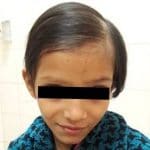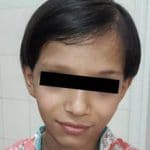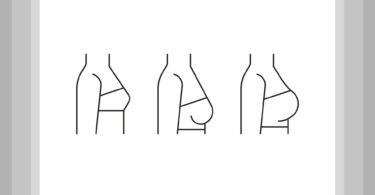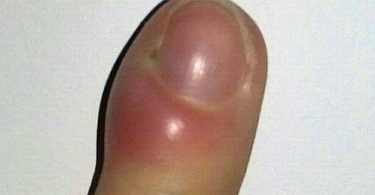Abstract:
The patient was a 6 year old girl who suffered from falling of hair in a patchy pattern. Internal and external allopathic treatments were tried for four years by three different dermatologists, but symptoms returned. This patient improved well after homeopathic treatment, not only at the local level but constitutionally as well, within one and half years. Treatment continued for about 2 years with more than one year follow up.
CASE PRESENTATION
Miss T. K. , age 6 years, was a diagnosed case of alopecia areata at the age of 2 years. On April 24, 2014, she was consulted for the homeopathic treatment of her relapsing complaint of hair falling in patches. She presented the following chief complaints at the time of examination.
Observations and Presenting Complaints
- Falling of hairs from scalp in patchy pattern.
- Patchy area presented with dark color.
- Falling of eye lashes and hairs of eye brows.
- Pale face, remaining hairs thin, lusterless and unhealthy.
- Scaly dandruff in head with mild itching.
- Body growth was not proper in height and weight.
- Thin chest.
- White spots on nails.
- She had poor appetite.
- Burning heat in soles.
- Desire salted and spicy food, cold drinks, ice cream.
- Aversion to sweets.
History of presenting illness
Patient was alright 4 years before, then she experienced itchy areas on scalp with falling of hair from these areas. Her elder sister also had h/o alopecia areata and responded well with allopathic treatment with no relapse. So, her parents confidently sought a dermatologist’s opinion and treatment was begun. First treatment was of 6 months with recovery and then relapses after 3 months. Second treatment was given for 3 years, including internal medication and external injection therapy. Within a few weeks of stopping treatment, hair fall continued. Another course of treatment was given for 9 months but without any positive result.
Past Personal History
H/o Chicken pox
Family History
H/o tuberculosis in Mother
PHYSICAL GENERALS
Appetite : Diminished
Thirst : Excessive for cold water
Desires : Salted, spicy foods, cold drinks
Aversion : Sweets
Bowel Habits : Normal
Urination : Normal
Perspiration : Normal
Sleep : Normal
Thermal reaction : Hot patient
AN INNOCENT WISH
She had strong wish to wear a hair catcher but not enough hairs to hold the hair catcher.
REMEDIES SELECTION
- Constitutional: Phosphorus
- Intercurrent: Sulfur, Acid Fluor
- Acute episode: Sulph, Hepar Sulf,
- Family History: Tuberculinum
- Supportive: Calc phos, Nat Mur
RESULTS & DISCUSSION
Constitutionally and symptomatically this patient was a phosphorus, and one dose in 200 was advised and three doses were given with intervals during 2 months as needed. According to W.A. Dewey, phosphorus is the most important remedy in alopecia areata that presents with bald spots on the head which are dry and scaly72.
Hair started growing out, but after 2 months of starting treatment the patient developed itching on affected area of head. I consider it a positive response of the body as the same symptom was experienced by the patient at startup of the problem (which was suppressed by local steroid creams and injection). I decided to wait for some time to observe any change in symptoms. Meanwhile due to itching, the patient badly scratched the area and got secondary infection with pustular, scaly eruptions. A few doses of Sulfur 30 and Hepar sulph 30 were needed here according to symptoms, which cleared the problem.
Echinacea MT 10 drops thrice a day was prescribed for 3 weeks to enhance general immunity. Afterward a dose of Sulfur 200 was administered as an antipsoric and intercurrent remedy73. It was observed that the growing hairs were not healthy and looked thin, dry and lusterless. Patient was not taking appropriate foods, so a balanced diet was advised. Alder Smith says alopecia areata “is due to a state of perverted nutrition and not to any vegetable parasite,”74. Cowperthwaite A. C. described Flouric acid as a valuable remedy in disorders resulting from perverted nutrition and in unhealthy, broken down constitutions75. Flouric acid is mentioned in the literature as an intercurrent remedy in alopecia areata76. Two doses of acid fluor 200 were prescribed with intervals of 20 days.
Hairs were continually grown out but with no shine. A dose of Tuberculinum in 1M was administered due to H/o TB in her mother and followed by Calc Phos 6x and Nat Mur 6x alternately twice a day and continued until recovery. It gave a new vitality not only to the hair, but the patient. Now she has good complexion, dark and thick hairs and good height. In my daily practice these two salts are very effective in children with malnutrition and weak health and Silicea is a third one. In the homeopathic literature, biochemic salts including Kali phos77, Nat Mur78-79 and Calc phos80-81 are mentioned for the treatment of alopecia areata.
References
- Cash T: The psychosocial consequences of androgenetic alopecia: a review of the research literature. Br J Dermatol 1999; 141: 398-405.
- Madani S, Shapiro J: Review: Alopecia areata update., J Am Acad Dermatol. 2000 Apr; 42(4):549-66; quiz 567-70.
- Alkhalifah A, Alsantali A, Wang E, McElwee KJ, Shapiro J: Alopecia areata update: part I. Clinical picture, histopathology, and pathogenesis., J Am Acad Dermatol. 2010; 62(2):177-88.
- Paus R, Cotsarelis G: The biology of hair follicles. N Engl J Med 1999; 341: 491-7.
- Courtois M, Loussouarn G, Hourseau S, Grollier JF: Periodicity in the growth and shedding of hair. Br J Dermatol 1996; 134: 47-54.
- Le Cleach L, Chosidow O: Clinical practice. Lichen planus. N Engl J Med 2012; 366: 723-32.
- McDonagh AJ, Tazi-Ahnini R. Epidemiology and genetics of alopecia areata.Clin Exp Dermatol.2002; 27:405-9.
- Gilhar A, Etzioni A, Paus R: Alopecia areata. N Engl J Med 2012;366:1515-1525.
- Safavi KH, Muller SA, Suman VJ, Moshell AN, Melton LJ: Incidence of alopecia areata in Olmsted County, Minnesota, 1975 through 1989. Mayo Clin Proc. 1995; 70(7):628-633.
- Alkhalifah A, Alsantali A, Wang E, McElwee KJ, Shapiro J: Alopecia areata update: part II. Treatment. J Am Acad Dermatol. 2010; 62(2):191-202, quiz 203.
- Gilhar A, Etzioni A, Paus R: Review:Alopecia areata., N Engl J Med. 2012 Apr 19; 366(16):1515-25.
- Seirafi H, Ehsani A, Hosseini MS, Samavati B, Gholamali F, Noormohammadpour P. Comparison of thyroid function tests in alopecia totalis and universalis with control group.Tehran Univ Med J. 2013; 71:238-43.
- Freyschmidt-Paul P, Happle R, Hoffmann R: Alopecia areata. Klinik, Pathogenese und rationale Therapie einer T-Zell-vermittelten Autoimmunerkrankung. Hautarzt 2003; 54: 713-22.
- Betz RC, Petukhova L, Ripke S, et al.: Genome-wide meta- analysis in alopecia areata resolves HLA associations and reveals two new susceptibility loci. Nat Commun 2015; 6: 5966.
- Nagai Y, Ishikawa O, Hattori T, Ogawa T: Linear lupus erythematosus profundus on the scalp following the lines of Blaschko. Eur J Dermatol. 2003;13:294-6
- Shin MK, Cho TH, Lew BL, Sim WY: A case of linear lupus erythematosus profundus on the scalp presenting as alopecia. Korean J Dermatol. 2007; 45:1280-3.
- Bickers DR, et al.:The burden of skin diseases: 2004 a joint project of the American Academy of Dermatology Association and the Society for Investigative Dermatology. J Am Acad Dermatol. 2006; 55(3):490-500.
- Maedeh R, Shirin F, Sara Z: The Most Frequent Herbs Proposed by Iranian Traditional Medicine for Alopecia Areata. IJMS. 2016; 41:3.
- Gilhar A, Etzioni A, Paus R: Alopecia areata. N Engl J Med 2012; 366: 1515-25.
- Biran R, Zlotogorski A, Ramot Y: The genetics of alopecia areata: new approaches, new findings, new treatments. J Dermatol Sci 2015; 78: 11-20.
- McElwee KJ, Gilhar A, Tobin DJ, Ramot Y, Sundberg JP, Nakamura M, Bertolini M, Inui S, Tokura Y, King LE Jr, Duque-Estrada B, Tosti A, Keren A, Itami S, Shoenfeld Y, Zlotogorski A, Paus R: What causes alopecia areata? Exp Dermatol 2013; 22:609-626.
- Gandhi V, Baruah MC, Bhattacharaya SN: Nail changes in alopecia areata: incidence and pattern. Indian J Dermatol Venereol Leprol. 2003 Mar-Apr; 69(2):114-5.
- Kasumagic-Halilovic E, Prohic A: Nail changes in alopecia areata: frequency and clinical presentation., J Eur Acad Dermatol Venereol. 2009 Feb; 23(2):240-1.
- Islam N, Leung PS, Huntley AC, and Gershwin ME: The autoimmune basis of alopecia areata: A comprehensive review. Autoimmun Rev. 2015; 14:81–9.
- Bakry OA, El Shazly RM, Basha MA, Mostafa H.:Total serum immunoglobulin E in patients with alopecia areata. Indian Dermatol Online J. 2014; 5:122-7.
- Hewison M. An update on Vitamin D and human immunity. Clin Endocrinol (Oxf) 2012; 76:315-25.
- Arnson Y, Amital H, Shoenfeld Y. Vitamin D and autoimmunity: New aetiological and therapeutic considerations. Ann Rheum Dis. 2007; 66:1137-42.
- Review:Overview of general physiologic features and functions of vitamin D.DeLuca HF Am J Clin Nutr. 2004 Dec; 80(6 Suppl):1689S-96S.
- Ola AB,Shawky M El Farargy, Maathir K El Shafiee, and Amira S: Serum Vitamin D in patients with alopecia areata, Indian Dermatol Online J. 2016 Sep-Oct; 7(5): 371-377.
- Aksu Cerman A, Sarikaya Solak S, Kivanc Altunay I: Vitamin D deficiency in alopecia areata., Br J Dermatol. 2014 Jun; 170(6):1299-304.
- Yilmaz N, Serarslan G, Gokce C. Vitamin D concentrations are decreased in patients with alopecia areata.Vitam Trace Elem.2012;1:1-4.
- Mahamid M, Abu-Elhija O, Samamra M, Mahamid A, Nseir W:Association between vitamin D levels and alopecia areata. Isr Med Assoc J. 2014 Jun; 16(6):367-70.
- Messenger AG, McKillop J, Farrant P, McDonagh AJ, Sladden M: British Association of Dermatologists’ guidelines for the management of alopecia areata 2012. Br J Dermatol 2012; 166: 916-26.
- Daniel Asz-Sigall a Ana Cecilia González-de-Cossio-Hernández b Erika Rodríguez-Lobato b María Fernanda Ortega-Springall c Maria Elisa Vega-Memije c Roberto Arenas Guzmán d: Skin Appendage Disord; Differential Diagnosis of Female-Pattern Hair Loss. 2016;2:18–21.
- Kavak A, Baykal C, Ozarmagan G, Akar U. HLA in alopecia areata. Int J Dermatol. 2000;39:589-92.
- Delamere FM, Sladden MM, Dobbins HM, Leonardi-Bee J. Interventions for alopecia areata. Cochrane database Syst Rev. 2008;(2)
- Delamere FM, Sladden MM, Dobbins HM, Leonardi-Bee J. Interventions for alopecia areata. Cochrane Database Syst Rev. 2008;(2)
- Amor KT, Ryan C, Menter A. The use of cyclosporine in dermatology: part I. J Am Acad Dermatol 2010;63:925-946.
- Alkhalifah A, Alsantali A, Wang E, McElwee KJ, Shapiro J. Alopecia areata update: part II. Treatment. J Am Acad Dermatol 2010;62:191-202.
- Yang CC, Lee CT, Hsu CK, Lee YP, Wong TW, Chao SC, et al. Early intervention with high-dose steroid pulse therapy prolongs disease-free interval of severe alopecia areata: a retrospective study. Ann Dermatol 2013;25:471-474.
- Gilhar A, Etzioni A, Paus R: Review: Alopecia areata. N Engl J Med. 2012 Apr 19; 366(16):1515-25.
- Burnett JC: Diseases of the skin, B. Jain Publishers Pvt. Ltd, New Delhi , 2004.
- Raue CG: Diseases of Children, 2nd edition, , Jain Publishers Pvt. Ltd, New Delhi, 2000.
- Rawat PS: Homeopathy in Acne and Alopecia, Jain Publishers Pvt. Ltd, New Delhi, 1999.
- Hahnemann S: Organon of the Medical Art. 6th edition. Edited by Wenda Brewster O’Reilly, Birdcage Books, 2001.
- Clarke JH: A Dictionary of Practical Materia Medica, Volume 1-3. Bradford, UK: Health Science Press; 1977.
- Steinsbekk A, Ludtke R: Patients’ assessments of the effectiveness of homeopathic care in Norway: a prospective observational multicenter outcome study. Homeopathy 2005, 94(1):10-16.
- Kliems H, Witt CM: The good doctor: a qualitative study of German homeopathic physicians. J Altern Complement Med 2011, 17(3):265-270.
- Witt C, Albrecht H (Eds): New Directions in Homeopathy Research. Essen, Germany: KVC Verlag; 2009.
- Bornhoft G, Matthiessen PF: Homeopathy in Healthcare – Effectiveness. Appropriateness, Safety, Costs: Springer; 2011.
- Thomson P, Jones J, Browne M, Leslie SJ: Why people seek complementary and alternative medicine before conventional treatment: a population based study. Complement. Clin. Pract. 2014, 20(4):339-346.
- Jean D, Cyr C: Use of complementary and alternative medicine in a general pediatric clinic. Pediatrics, 120(1), 138-141.
- Maria TC,Christine W, Fredi K,., Debra K, and Linda F C: Women’s Reasons for Complementary and Alternative Medicine Use: Racial/Ethnic Differences, J Altern Complement Med. 2006; 12(8): 719-720.
- Barnes PM, Powell-Griner E, McFann K, Nahin RL Adv Data Complementary and alternative medicine use among adults: United States, 2004, 27(343):1-19.
- Eddy DM: Evidence-based medicine: a unified approach. Health Aff (Millwood). 2005; 24(1):9-17.
- Steuter E: Contesting the rule(s) of medicine: homeopathy’s battle for legitimacy. Journal of Canadian Studies (Special Issue on Science and Politics in Canada.) 2002, 37(3):1-20.
- Roy R K, 2003, Homoeopathy in Cancer Treatment, Jain Publishers Pvt. Ltd, New Delhi, p 57
- Homoeopathic Dose and Dilutions, By R K Mukherji, Jain Publishers Pvt. Ltd, New Delhi, 2003, p 80
- Organon of Homeopathy by Samuel Hahnemann, Jain Publishers Pvt. Ltd, New Delhi, 2002.
- Dhawale M. L., Principles and Practice of Homeopathy, Institute of Clinical Research, Bombay, India, 1985.
- Banerjee P.N., Chronic Disease, Its Cause and Cure, Jain Publishers (P) Limited, 1985.
- Kleijnen J, Knipschild P, ter Riet G: Clinical Trials of Homeopathy. BMJ 1991, 302:316-23.
- Hill C, Doyon F. Review of randomized trials of homeopathy. Rev Epidemiol Santé Pub 1990; 38:39-47.
- Kurz R. Clinical medicine versus homeopathy. Padiatric Padology 1992; 27(2):37-41.
- Aulas J. Homeopathy update. Préscrire Int 1996; 15(155):674-84.
- Practical gleanings , The Homoeopathic Recorder, 1886,
- Hughes R and Dake JP: A Cyclopaedia of Drug Pathogenesy
- Freyschmidt-Paul P, Happle R, Hoffmann R: Alopecia areata. Klinik, Pathogenese und rationale Therapie einer T-Zell-vermittelten Autoimmunerkrankung. Hautarzt, 2003; 54: 713–22. 21.
- Tosti A, Bellavista S, Iorizzo M: Alopecia areata: a long term followup study of 191 patients. J Am Acad Dermatol 2006; 55: 438-41.
- Madani S, Shapiro J: Alopecia areata update. J Am Acad Dermatol 2000;42:549-566.
- Lew BL, Shin MK, Sim WY: Acute diffuse and total alopecia: A new subtype of alopecia areata with a favorable prognosis. J Am Acad Dermatol 2009;60:85-93.
- Dewey W. A., Practical Homeopathic Therapeutics, Jain Publishers Pvt. Ltd, New Delhi, reprint 2005.
- Pai PN: Homoeopathy in daily practice, the association of homoeopathic physicians, Bombay, 1979.
- Ringworm : its Diagnosis and Treatment,” London, 1885
- Cowperthwaite AC: Text book of Materia Medica and Therapeutics, WENTWORTH Press, Reprint 2016.
- Koehler G, Lehrbuch D: Homoeopathie (2 vol), 1988, Hippokrates Verlag, Stuttgart.
- HANSEN O: A Text-Book of Materia Medica and Therapeutics of Rare Homeopathic Remedies, Health research books, 1993.
- Douglass ME: Skin Diseases, Jain Publishers Pvt. Ltd, New Delhi, reprint 2001.
- Herscu P: The Homeopathic Treatment of Children, North Atlantic Books, 1991.
- Rastogi DP: Homeopathic Gems. South Asia Books, 2002.
- Vithoulkas G., Materia Medica Viva. Jain Publishers Pvt. Ltd, New Delhi, 2002.








